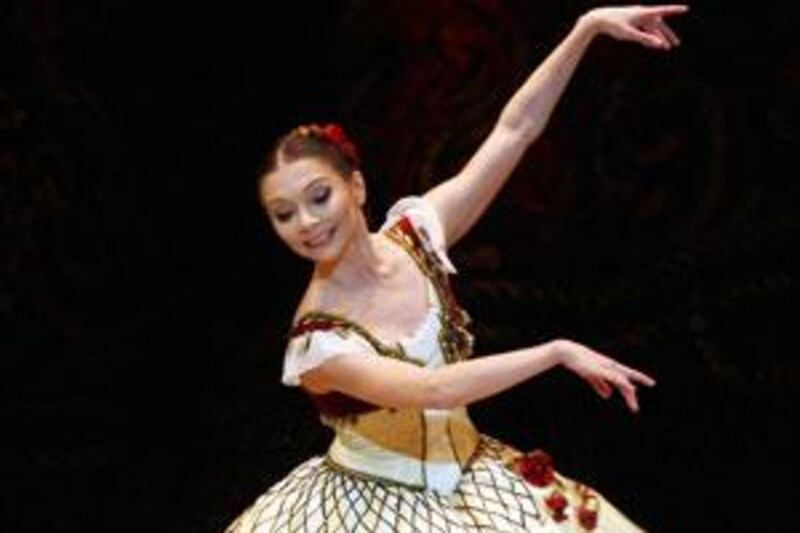There exists great significance behind the Bolshoi Ballet's performances at the Emirates Palace this week, for since the beginning of January it has been under the command of a new artistic director, Yuri Burlaka. His appointment was a surprise announcement last March, much remarked upon in the ballet world because it set the departure date for Alexei Ratmansky, a choreographer widely credited with having revitalised the ballet company's style upon his appointment in 2004.
Burlaka has a particular specialism in recreating 19th-century ballet, as evidenced by the choice of Ludwig Minkus' Paquita to open proceedings at the Bolshoi's opening gala at the Abu Dhabi Music and Arts Festival and, as will be demonstrated tonight and tomorrow, by the company's version of Giselle. For the opening night, a divertissement was compiled, meaning the first act was dominated by Paquita's Grand Pas and the second was taken up with a mêlée of pieces from five different ballets.
In truth, Paquita's Grand Pas could have been a more vibrant, exciting opening from one of the world's greatest ballet companies. It was launched into by the ballet de corps, followed by the principal dancers and leads, who appeared alternately solo or in pairs but waltzed on and off in a manner that didn't lend much fluidity to proceedings. The story of Paquita is a marvellous one, set in Napoleon's Spain. Paquita is the heroine, who was abducted and raised by gypsies when young. Having saved the life of a noble French officer, Lucien, from the gypsy chief she later discovers she too is of noble birth and is able to leave the gypsies and marry the officer. The trouble with this performance, though, was that just one act couldn't convey the whole story but, at 45 minutes, it felt too long to hold audience attention as a showpiece.
The principal male dancer Alexander Volchkov was technically brilliant, performing with great panache and in a fittingly imperial manner. So too was his opposite lead, Maria Alexandrova, extraordinarily dainty in her pointe work. But when the entire ballet de corps appeared on stage it felt as if the production hadn't quite gelled. More captivating was the second act, which opened with everyone's favourite ? Tchaikovsky's Nutcracker and its waltz and Pas de Deux. How many times must even the youngest of ballet-goers have witnessed this show? The Christmas story of a girl transported to a dream world of giant toys, sweets and fairies is supported by beguiling music and a glorious ensemble of characters. Constructed in 1892 by Tchaikovsky; Marius Pepita, the master choreographer, and Ivan Vsevolozhsky, the director of the Imperial Theatre it still possesses a charm and innocence well portrayed here by Anna Nikulina dancing lightly as Clara.
Next up was the Pas de Deux from La Sylphide, danced by the kilted male lead Artem Ovcharenko and partnered by Anastasia Goryacheva. One of the oldest romantic ballets in existence, it premiered in Paris in 1832. While Ovcharenko had the edge on his partner in terms of deftness, Goryacheva was wonderfully playful as the mischievous sylph leading the groom astray. Then to the most anticipated act of the evening, a dance from Minkus's Don Quixote starring the 19-year old Ivan Vasiliev. No relation to the company's hero of the 1960s and 1970s, Vladimir Vasiliev, he has been hailed as the next Baryshnikov and often dubbed "the boy who can fly". That he did, leaping high in the air with all the swagger that the role demanded and executing lightning pirouettes with astonishing athleticism opposite his similarly feted star, Natalia Osipova, famed for her jumps. It was a breathtaking display, and one which felt all too brief.
The penultimate dance, Pas de Deux from Riccardo Drigo's The Talisman, was set in ancient India, but just as Don Quixote seemed too short, this felt too long. The male lead Egor Khromushin came close to Vasiliev in terms of prowess but, again, the staccato nature of the performance meant the display lacked flow. Proceedings were wrapped up with the grand spectacle of Léo Delibes' Le Corsaire, based on the poem written by Byron. At its core it is a swashbuckling tale of pirates, though you wouldn't have known it from the dance performed, taken from a scene where the Pasha falls asleep and dreams of his wives (the entire female corps de ballet) turning into flowers and dancing for him. Swaying garlands of flowers made it a wonderfully delicate sight. A grand note to finish on, one which demonstrated why the Bolshoi and its outstanding orchestra retain their preeminent reputation for staging ambitious and admirably showy performances.










